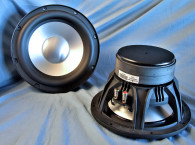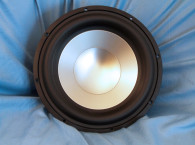
Wavecor’s SW223BD03, which is the 8 Ω version, has a generous feature set that includes a proprietary eight-spoke cast aluminum frame that has minimal reflection surfaces and is completely open below the spider mounting shelf. Other features include a very stiff flat black anodized aluminum cone, further stiffened by a 3.5” convex black anodized aluminum dust cap. Suspension is provided by a low-loss (high Qm) NBR surround plus a 5” diameter black flat cloth spider (damper).
All this is driven by a 51-mm diameter (2”) voice coil wound with round wire on a black fiber glass non-conducting former. The motor system powering the cone assembly utilizes two 20-mm thick 125-mm diameter ferrite magnet sandwiched between a black plated 6-mm thick front plate and a black plated and shaped T-yoke that does not use a pole vent. This format drives more air out the gap area and across the front plate below the spider mounting shelf for enhanced cooling of the motor system. The SW223BD03 further incorporates an aluminum shorting ring (Faraday shield) that reduces distortion caused by eddy currents. Last, the braided voice coil lead wires terminate to a pair of gold terminals.
I began characterizing the new SW223BD03 8.75” subwoofer using the LinearX LMS analyzer and VIBox to measure voltage and admittance (current). Sweeps were generated in free air at 1, 3, 6, 10, 15, and 20 V.


The measured Mmd that was provided by Wavecor (an actual physical cone assembly measurement with 50% of the surround and spider removed) was used rather than a single 1 V added (delta) mass measurement. It should also be noted that this multi-voltage parameter test procedure includes heating the voice coil between sweeps for progressively longer periods to simulate operating temperatures at that voltage level (raising the temperature to the first and second time constants).
The 12 sine wave sweeps for each woofer were further processed with the voltage curves divided by the current curves to produce impedance curves. I generated phase curves using the LEAP phase calculation routine. After which I copy/pasted the impedance magnitude and phase curves plus the associated voltage curves into the LEAP 5 Enclosure Shop software’s Guide Curve library. I used this data and the LEAP 5 LTD transducer model to calculate parameters.
Because most manufacturing data is produced using either a standard transducer model or in many cases the LEAP 4 TSL model, I also generated LEAP 4 TSL model parameters using the 1 V free air to compare it with the manufacturer’s data. Figure 1 shows the SW223BD03 1 V free-air impedance plot. Table 1 compares the LEAP 5 LTD and LEAP 4 TSL Thiele-Small (T-S) parameter sets for the Wavecor SW223BD03 driver samples along with the Wavecor factory data.
From the comparative data shown in Table 1, you can see that all four parameter sets for the two samples were reasonably similar and correlated well with the factory data.
Following my normal protocol for Test Bench testing, I used the Sample 1 LEAP 5 LTD parameters and set up two computer box simulations, one in a 0.6 ft3 Butterworth-type sealed enclosure with 50% fill material (fiberglass). For the second example, I decided to use the data from a Wavecor 10” passive radiator, the PR263WA01. This resulted in a 0.89 ft3 box with 15% fill material and tuned to 16 Hz. Wavecor has all the weights figured out for the drone for different tunings, and for the PR263WA01, it takes 355 grams, 255 grams for the “naked” PR263WA01, plus an additional 100 grams.



Figure 2 gives the results for the SW223BD03 in the sealed and drone enclosures at 2.83 V and at a voltage level sufficiently high enough to increase cone excursion to 13.5 mm (XMAX + 15%). This resulted in a F3 of 38 Hz (-6 dB = 31 Hz) with a Qtc = 0.68 for the 0.6 ft3 closed box and a -3 dB for the drone simulation
of 30 Hz (-6 dB = 24 Hz).
Increasing the voltage input to the simulations until reaching the approximate XMAX +15% maximum linear cone excursion point resulted in 105 dB at 33 V for the sealed enclosure simulation and 107 dB with a 34 V input level for the larger passive radiator box. Figure 3 shows the 2.83 V group delay curves and Figure 4 shows the 33 V/34 V excursion curves.
Klippel analysis for the SW223BD03 produced the Klippel data graphs shown in Figures 5–8. (Our analyzer is provided courtesy of Klippel GmbH and the analysis was performed by Patrick Turnmire, of Redrock Acoustics). The Bl(X) curve shown in Figure 5 is moderately broad and mostly symmetrical (with a bit of “tilt”), which is typical of a driver with a relatively high XMAX. Figure 6 shows the Bl symmetry curve, which has a small and not significant 0.89 mm Bl coil-out (forward) offset once you reach an area of reasonable certainty, staying constant to the physical 11.7 mm XMAX position and beyond.




Figure 7 and Figure 8 the KMS(X) and KMS symmetry curves for the SW223BD03. Like the Bl curve, the KMS stiffness of compliance curve shown in Figure 7 is very symmetrical, with only a minor offset. The KMS symmetry range curve exhibits a minor 1 mm coil-out (forward) offset at a region of high certainty (6 mm) that decreases to near zero by 8 mm. Displacement limiting numbers calculated by the Klippel analyzer using the subwoofer criteria for Bl was XBl at 70% (Bl dropping to 70% of its maximum value) equal to 12.1 mm for the prescribed 20% distortion level (the criterion for subwoofers). For the compliance, crossover (XC) at 50% CMS minimum was 12.5 mm, which means that for the SW223BD03, the Bl is the more limiting factor for getting to the 20% distortion level. However, both numbers were greater than the driver’s 11.7 mm physical XMAX.




Figure 9 gives the SW223BD03’s inductance curve Le(X). Motor inductance will typically increase in the rear direction from the zero rest position as the voice coil covers more of pole, however, that doesn’t happen here. We do get lower inductance variation from full in to full out travel, which is what you want to achieve. It’s easy to see the benefit of the aluminum shorting ring with inductance only varying about 0.04 mH, which is very minimal inductance change for such a large motor.
After the Klippel analysis was finished, I mounted the driver in an enclosure filled with foam damping material and that had a 15” × 9” baffle area and used the LMS gated sine wave technique to measure the SW223BD03’s SPL on and off axis. Figure 10 gives the on-axis response measured 300 Hz to 20 kHz at 2.83 V/1 m. The response is a smooth ±1.95 dB out to 2 kHz, with a breakup mode peak up 10 dB at 3.2 kHz. Figure 11 shows the on and off axis to 45°. Figure 12 shows the normalized response.

Figure 13 shows the Clio polar plot (using 10° increments). Even though this is a subwoofer, it certainly would be possible to use it in a three-way configuration with a low-pass crossover frequency as high as 1.6 kHz or so to a midrange driver and tweeter, or as a two-way to a large planar transducer.


Figure 14 gives the two-sample SPL comparison showing, as you would expect from Wavecor, the drivers to be well matched. Next, I used the Listen, Inc., SoundCheck analyzer to perform distortion and time domain analysis. I set the voltage level with the driver rigidly mounted in free air and increased the voltage until it produced a 1 m SPL of 94 dB (7.4 V) (which is my SPL standard for home audio drivers). I made the distortion measurement with the microphone placed near-field about 10 cm from the dust cap.
Figure 15 actually includes two plots, the top graph being the standard fundamental SPL curve with the second and third harmonic curves, and the bottom graph shows the second and third harmonic curves plus the total harmonic distortion (THD) curve with an appropriate X-axis scale. Interpreting the subjective value of conventional distortion curves is almost impossible. However, looking at the relationship of the second to third harmonic distortion curves is of value.
I used SoundCheck to get a 2.83 V/1 m impulse response (which was mounted in the enclosure with the 15” × 9” baffle). I imported the data into Listen’s SoundMap Time/Frequency software. Figure 16 shows the resulting CSD waterfall plot. Figure 17 shows the Wigner-Ville plot (which I used for its better low frequency performance). As you can see from this month’s explication, the SW223BD03 is another well crafted transducer from the engineers at Wavecor.
For more information, visit www.wavecor.com. VC


This article was originally published in Voice Coil, October 2016.







